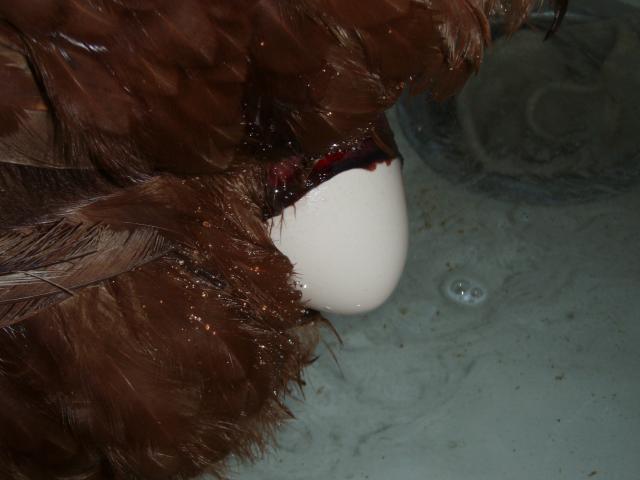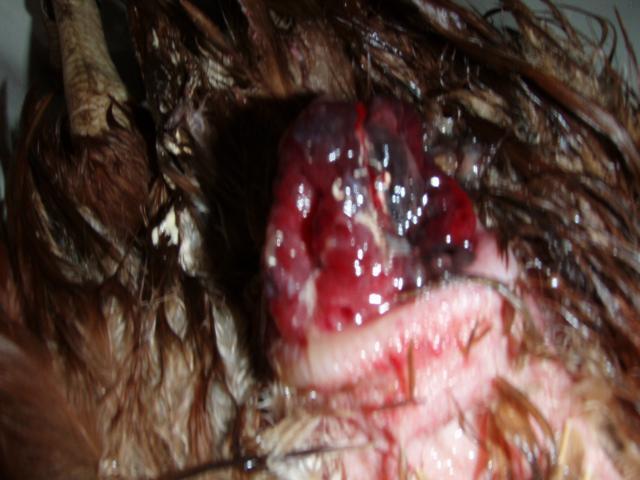Navigation
Install the app
How to install the app on iOS
Follow along with the video below to see how to install our site as a web app on your home screen.
Note: This feature may not be available in some browsers.
More options
You are using an out of date browser. It may not display this or other websites correctly.
You should upgrade or use an alternative browser.
You should upgrade or use an alternative browser.
Egg stuck halfway out- Unbelievable recovery
- Thread starter Scoot58
- Start date
Soak her in a tub of warm water. If that doesn't work, grease her up with olive oil and try to gently pull it out.
Gently feel above it see if you can't feel why it didn't come out. Is it really half way? Is it extra large? You can always try to lube it. Just be carefull not to break it.
Last edited:
- Thread starter
- #4
I would say you need to lube your fingers with olive oil and gently put it back and apply preparation H hemerroid cream to shrink the tissues and relieve the swelling.
If you do a search on "prolapsed vent", many threads will come up - here is one that seemed especially well worded and helpful.
https://www.backyardchickens.com/forum/viewtopic.php?id=157703
If you do a search on "prolapsed vent", many threads will come up - here is one that seemed especially well worded and helpful.
https://www.backyardchickens.com/forum/viewtopic.php?id=157703
Last edited:
- Apr 11, 2009
- 1,436
- 56
- 171
iSOLATE HER AND THEN PUT SEVERAL TIMES SOME prep H
IN THE VENT AND TRY PUSHING THE VENT AREA BACK IN
DO THE PREP H TWICE TONIGHT AND HOLD YOU HAND OVER THE VENT TO HOLD THE PROLAPSE IN
THE pREP H WILL SHRINK THE PROLAPSE
NOW KEEP HER WARM AND IN DARK PLACE SUCH AS A BOX WITH TOWEL IN IT
IF YOU HAVE A HEATING PAD PUT IT UNDER THE TOP LAYER OF THE TOWEL AND ON MIDIUM HEAT
THIS WILL KEEP HER HAPPY AND HEALING
DO THIS FOR THREE DAYS AND ONLY FEED HER A SLICE OF BREAD AND MILK THREE TIMES A DAY
THIS WILL HELP HER GUT FLORA ALSO
in the water put 1 pint of water with 1 tbsp of apple cider vinegar
any questions email me
IN THE VENT AND TRY PUSHING THE VENT AREA BACK IN
DO THE PREP H TWICE TONIGHT AND HOLD YOU HAND OVER THE VENT TO HOLD THE PROLAPSE IN
THE pREP H WILL SHRINK THE PROLAPSE
NOW KEEP HER WARM AND IN DARK PLACE SUCH AS A BOX WITH TOWEL IN IT
IF YOU HAVE A HEATING PAD PUT IT UNDER THE TOP LAYER OF THE TOWEL AND ON MIDIUM HEAT
THIS WILL KEEP HER HAPPY AND HEALING
DO THIS FOR THREE DAYS AND ONLY FEED HER A SLICE OF BREAD AND MILK THREE TIMES A DAY
THIS WILL HELP HER GUT FLORA ALSO
in the water put 1 pint of water with 1 tbsp of apple cider vinegar
any questions email me
- Thread starter
- #7
It needs to be relatively flush with the vent. Did you try preparation H? It causes shrinkage and contraction of the tissues.
By the way, egg binding like this is often a sign of calcium deficiency. We can work on that with you, too.
Laying flocks should be on a diet that is mainly laying pellets which are designed not only to provide calcium in sufficient amounts for laying, but also the supporting nutrients that help calcium absorbtion. It's a good idea to also provide free-choice calcium supplementation for birds who feel they need more. There are various forms of this on the market. It should be provided in a separate container from their food. I use oyster shell granules.
But calcium isn't enough. The bird's diets must not be high in grains (in addition to those in the pellets) because grains are high in phosphorus. While phosphorus is necessary for calcium being absorbed, it must be in a pretty exact proportion to the calcium. (2:1 calcium hos is the normal proportion). Too much phosphorus causes the avian body to extract calcium from the body, including bones, to make up for the need. Too mush phos will also result in soft shelled eggs, egg binding, and prolapse.
hos is the normal proportion). Too much phosphorus causes the avian body to extract calcium from the body, including bones, to make up for the need. Too mush phos will also result in soft shelled eggs, egg binding, and prolapse.
So 90% pellets, 10% treats and grains if you choose to give them.
The other most important part of providing calcium is vitamin D3. Vitamin D is usually found in feeds, but it's an oil vitamin which means it unfortunately can degrade in a dry non-oily source, with age of the feed, and in sunlight. If you suspect calcium problems in your birds, boost their D vitamins. Yogurt is a nice choice for this in small amounts as it provides calcium, vitamin D, and also living bacteria which help food use. Apple cider vinegar (organic only - not because of the philosophy but because of its make-up) is another good choice. It enhances calcium absorbtion and also provides enzymes, electrolytes, and living beneficial bacteria.
So when you get this hen on track, I'd give her a daily treat of yogurt, put some ACV in her water (1 ounce ACV per 1 gallon of water) for a week. Then do this occassionally during the month during heavy laying to keep things going nicely. I like once weekly or three days a month.
P.S. Be sure to clean the vent thoroughly to remove the blood. Preparation H will help with the fissures, tiny breaks, in her skin. When she doesn't prolapse anymore, try using a non-cortisone antibiotic ointment like Neosporin on her vent for a week.
By the way, egg binding like this is often a sign of calcium deficiency. We can work on that with you, too.
Laying flocks should be on a diet that is mainly laying pellets which are designed not only to provide calcium in sufficient amounts for laying, but also the supporting nutrients that help calcium absorbtion. It's a good idea to also provide free-choice calcium supplementation for birds who feel they need more. There are various forms of this on the market. It should be provided in a separate container from their food. I use oyster shell granules.
But calcium isn't enough. The bird's diets must not be high in grains (in addition to those in the pellets) because grains are high in phosphorus. While phosphorus is necessary for calcium being absorbed, it must be in a pretty exact proportion to the calcium. (2:1 calcium
 hos is the normal proportion). Too much phosphorus causes the avian body to extract calcium from the body, including bones, to make up for the need. Too mush phos will also result in soft shelled eggs, egg binding, and prolapse.
hos is the normal proportion). Too much phosphorus causes the avian body to extract calcium from the body, including bones, to make up for the need. Too mush phos will also result in soft shelled eggs, egg binding, and prolapse.So 90% pellets, 10% treats and grains if you choose to give them.
The other most important part of providing calcium is vitamin D3. Vitamin D is usually found in feeds, but it's an oil vitamin which means it unfortunately can degrade in a dry non-oily source, with age of the feed, and in sunlight. If you suspect calcium problems in your birds, boost their D vitamins. Yogurt is a nice choice for this in small amounts as it provides calcium, vitamin D, and also living bacteria which help food use. Apple cider vinegar (organic only - not because of the philosophy but because of its make-up) is another good choice. It enhances calcium absorbtion and also provides enzymes, electrolytes, and living beneficial bacteria.
So when you get this hen on track, I'd give her a daily treat of yogurt, put some ACV in her water (1 ounce ACV per 1 gallon of water) for a week. Then do this occassionally during the month during heavy laying to keep things going nicely. I like once weekly or three days a month.
P.S. Be sure to clean the vent thoroughly to remove the blood. Preparation H will help with the fissures, tiny breaks, in her skin. When she doesn't prolapse anymore, try using a non-cortisone antibiotic ointment like Neosporin on her vent for a week.
Last edited:
i know that looks terrible, but it really isn't that bad. It would help to soak her bottom in warm water with epson salts and sugar. My vet told me that one. You can do it several times a day. Then just keep gently pushing it back in until it stays. The warm soaks will help to shrink the tissue.
Also, it is a good idea to keep her in a dark quiet place. When this happened to my silkie i kept her inside in a hutch covered in a towel for actually about a week. You want to halt the egg-laying process and give that tissue a chance to heal.
Yummy treats are good too - nonfat plain yogurt, chopped hard boiled egg, cucumber.
Good luck, and let us know how it goes.
Also, it is a good idea to keep her in a dark quiet place. When this happened to my silkie i kept her inside in a hutch covered in a towel for actually about a week. You want to halt the egg-laying process and give that tissue a chance to heal.
Yummy treats are good too - nonfat plain yogurt, chopped hard boiled egg, cucumber.
Good luck, and let us know how it goes.
- Thread starter
- #10
You guys are the best. I am so happy you were here. I am getting her all set up in the dog crate until she heals. I am taking notes and making a shopping list. I love the suggestions. Keep them coming.
Thank you!
And Betty thanks you. You should have seen the look on her face when I got the egg out. I think I had the same look when my first child came out!
Thank you!
And Betty thanks you. You should have seen the look on her face when I got the egg out. I think I had the same look when my first child came out!
New posts New threads Active threads
-
Latest threads
-
Marans club USA, is it a waste of money?
- Started by Kung_pao
- Replies: 3
-
-
-
Swollen white-yellow lump on hen's toe. What is it?
- Started by Bakawk
- Replies: 1
-
-
Threads with more replies in the last 15 days
-
-
-
-
Heater or heat panel -10
- Started by IowaCHKN
- Replies: 94
-
-
×



